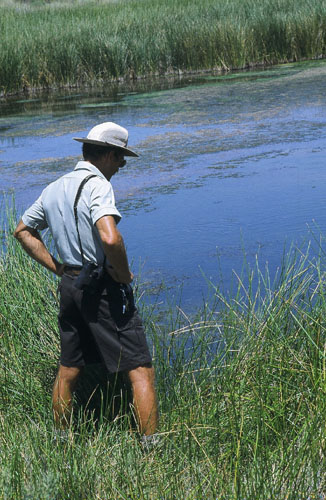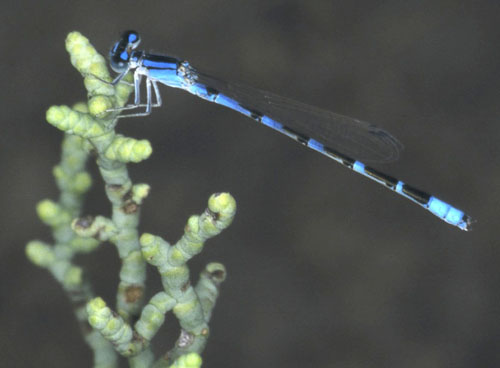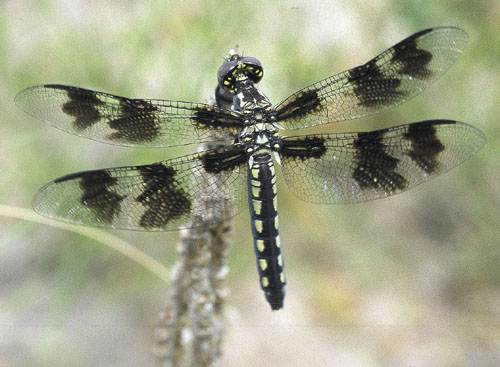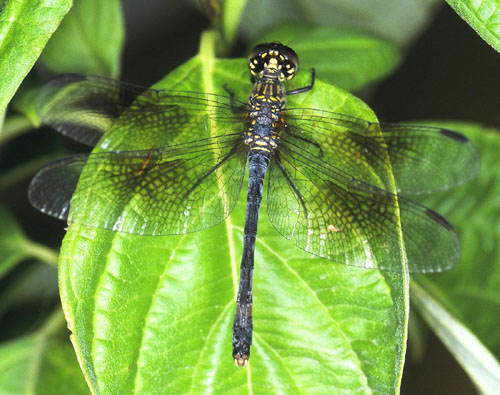The huge sinkhole lay shimmering in front of me as I walked toward its edge. My first impression was of the variety of dragonflies and damselflies that were flying around its edges. The U.S. Fish and Wildlife biologist who stood next to me was understandably proud of the area where he worked for it contained several endangered fish, invertebrates, and birds, and was now known for the largest number of species of Odonata in one spot in the whole of the United States. Over eighty species have been collected within its boundaries. Indeed, Bitter Lake National Wildlife Refuge is one of the lesser-known gems in the refuge system. It consists of three units, with a total area of about 10,000 hectares, along the Pecos River just northeast of Roswell, New Mexico. Here the Pecos flows through an area of gypsum sinkholes, various oxbows, man-made impoundments, Bitter Creek and one large playa (seasonal shallow lake) which gives the Refuge its name. I was used to the limestone sinkholes of Florida and sinkholes in gypsum were new to me. In fact the whole area was new to me and I only recognized a few plants such as four-wing saltbush and the introduced pest tree tamarisk.
|

Gordon Warrick at one
of the larger sinkholes, Bitter Lake National Wildlife Refuge. |
The sinkhole that stretched in front of Gordon Warrick and me was one
of the larger ones. Nearby was Sago Spring, with its population of endangered spring snails and amphipods. These were tiny creatures, unlike the charismatic megafauna usually implied in the public mind when the word “endangered” is used. However the most exciting fauna to me were the odonates, which hovered and hawked in every direction. The largest were the darners of the family Aeshnidae (Aeshna multicolor and Anax junius). I also noted Libellula saturata, a bright orange-red skimmer (family Libellulidae). The males of this brilliant species are hard to miss as they patrol back and forth across the surface. At nearby sinkholes and adjacent grasslands I easily identified the
males and females of the desert whitetail, Plathemis subornata, because
of their banded wings and distinctive abdominal markings. Another interesting find was the seaside dragonlet (Erythrodiplax berenice), a dark small dragonfly that is usually found along Atlantic beaches! In the plants growing around the sinkhole numerous damselflies, members of the families Coeagrionidae and Lestidae, flitted lazily. The bluets (Enallagma spp.), dancers (Argia sp.) and forktails (Ischnura spp.) were very abundant, while the spreadwings (Lestes sp.) were less common, but easily spotted by their size and habit of keeping their wings half open.
|

Male Tule Bluet (Enallagma carunculatum). Bitter Lake National Wildlife
Refuge. |
Dragonflies and damselflies are very ancient insects. Their ancestors were flying around the coal swamps in the Carboniferous and by the Jurassic were indistinguishable from modern species. Thus these amazing creatures survived the huge Permian extinction as well as the more famous Cretaceous extinction that put an end to the dinosaurs. Their closest living relatives are the mayflies, with which they make up a sub group of the Insecta called the Paleoptera, or ancient wings. Some ancient dragonflies had wingspans of over half a meter, but by the Jurassic they seem to have all been very close to modern dragonflies in size. Probably the most ancient of dragonflies lineages belongs to the family Petaluridae, which has two North American species, one from the East Coast and one from the West Coast.
|

Male Dancer (Argia sp.). Bitter Lake National Wildlife
Refuge.
|
In the United States the largest dragonflies are
the Aeshnids, or darners, that reach around 10 cm in wingspan and the smallest
are the amberwings and the elfin skimmer (Perithemis and
Nannothemis), which at a body length of about 25 mm are tiny by
comparison. Most damsel flies appear even smaller because of their slender
bodies. Dragonflies are strong fliers, especially the darners and skimmers, while damselflies are less agile and more delicate. I have caught many damselflies by hand, but only a few dragonflies, such as the amberwing, have fallen to me in this manner.
The feeding habits of adult odonates are quite impressive. The six legs usually serve as a basket to catch and hold prey in the air. In the giant tropical damselflies in the family Pseudostigmatidae at least some species can hover in front of spider webs and pluck the spider off! Large feeding flights are common in some species of dragonflies. These can be seen sometimes near dusk darting across the sky as they seize flying insects from the air. A few species are even nocturnal, but most can be seen patrolling their territories during the daylight hours along the edges of lakes, streams, rivers, ponds and even stock tanks. Some may be found far from water even in the middle of a desert.
|

Female Desert Whitetail (Plathemis subornata). Bitter Lake National
Wildlife Refuge.
|
The larvae (nymphs or naiads) of the Odonata are unique. They are predatory and like little dragons lurk in algae and other vegetarian to catch the unwary tadpole, small fish, or another arthropod with their extensible lip or labium. This structure is a remarkable one in that it is elbowed in such a way to slide under the head when not in use. In some families (such as the Libellulidae) it forms a mask over the lower face of the larva. Damselfly larvae generally have slender bodies and external, leaf-like gills at the end of the abdomen. Dragonfly larvae are generally fatter and have internal gills in the rectal area. They can also escape enemies by means of expelling water out their anus, propelling themselves forward. Occasionally dragonfly larvae can become pests at hatcheries.
I have always admired the beauty of dragonflies. From the first time I read an article written by J. G. Needham in the National Geographic I was enchanted with these creatures of both air and water. I read about them in books like Lutz's Field Book of Insects and watched them as they skimmed over irrigation and drainage ditches along the lower Colorado River of Arizona. Later I collected them around Tucson, Arizona, for my class in general entomology and then for my own collection in Florida. I especially remember netting two species of Celithemis at Archbold Biological Station north of Lake Okeechobee because the article I had read in the National Geographic had photographs of the area around Archbold. The Halloween pennant (Celithemis eponina) was even shown in the National Geographic article. The banded pennant (C. fasciata) was not, but it is still a very beautiful dragonfly. Interestingly, both of these beauties have been collected at Bitter Lake National Wildlife Refuge, far from the Florida scrub.
|

Female Seaside Dragonlet (Erythrodiplax berenice). Bitter Lake National
Wildlife Refuge.
|
These days people are more likely to be watching dragonflies than catching them, although some must be caught occasionally for documentation. Several guides are now available much like the bird and butterfly guides that allow you to identify them with binoculars or by catch and release. Of course photography is even more helpful. Also numerous Internet sites have excellent photographs of odonates, some so sharp that you can count the cells in the wings! If you are really interested in Odonata the best all around book on the subject is Dragonflies of the World by Jill Silsby. Despite the title, damselflies are also included. This beautiful and informative book is filled with color photos and can be used anywhere on the planet where odonates are found.
A good dissecting microscope is, however, sometimes needed for identification, especially of the larvae. Adults that are difficult to identify with binoculars may be caught, examined with a hand lens and then released. Microscopic examination of eggs and early instar larvae is to a large extent still an open frontier.
However you look at the odonates, they are a fascinating order and the adults are among the most beautiful of insects. Adults consume huge numbers of mosquitoes and other pests, and are thus quite useful from a human perspective. You also have to respect a group of insects that survived both the extinction events that took first the trilobites and then the dinosaurs!
Comments to the author, David
Richman, are welcomed.
All photos by
and © David B. Richman.
© Microscopy UK or their
contributors.
Published in October
2003 Micscape Magazine.
Please report any Web
problems or offer general comments to the
Micscape
Editor.
Micscape is the
on-line monthly magazine of the Microscopy UK web site
at
Microscopy-UK.
© Onview.net Ltd,
Microscopy-UK, and all contributors 1995 onwards. All
rights reserved. Main site is at
www.microscopy-uk.org.uk
with full mirror at
www.microscopy-uk.net
.




